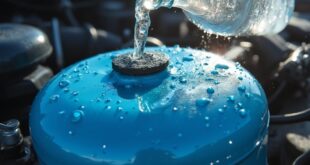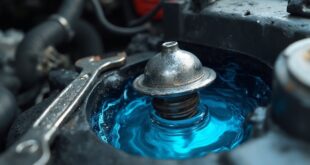If your car's running hot but not overheating, it could be due to several issues affecting the cooling system. A bad thermostat might restrict coolant flow, while a clogged radiator can fail to dissipate heat. You might also have a malfunctioning water pump or low coolant levels. If you notice fluctuating temperature readings, it's essential to address these problems early. Find out more about diagnosing and maintaining your cooling system to prevent further issues.
Understanding Engine Temperature and Normal Ranges
When you're driving, it's crucial to understand engine temperature and what's considered normal. Typically, your engine should run between 195°F and 220°F. If the temperature gauge creeps toward the red zone, it signals a potential issue.
Familiarizing yourself with the gauge helps you catch problems early. You'll want to monitor any fluctuations closely, especially during heavy traffic or hot weather. Keeping an eye on temperature allows you to take proactive measures before serious damage occurs.
Regular checks can save you time and money, ensuring your engine operates efficiently and reliably throughout its lifespan.
Common Causes of High Engine Temperature
High engine temperatures can stem from various issues that disrupt the cooling system's efficiency.
A bad thermostat may delay coolant flow, causing your engine to run hot. If your radiator's clogged or defective, it can't transfer heat effectively, leading to overheating. A faulty coolant temp sensor might misread temperatures, resulting in improper coolant distribution.
Additionally, a failing water pump won't circulate coolant efficiently. Low coolant levels, air pockets in the system, or a blocked airflow can also elevate temperatures.
Finally, pushing your engine too hard in hot weather or heavy traffic can make things worse.
Signs and Symptoms of Cooling System Issues
Recognizing the signs and symptoms of cooling system issues is essential for preventing serious engine problems.
You might notice fluctuating temperature gauge readings, which can indicate a bad thermostat or low coolant levels. If your engine struggles to reach ideal temperature or you feel no heat from the cabin vents, a stuck thermostat could be the culprit.
Intermittent overheating can also signal inadequate coolant or air in the system. Pay attention to these warning signs, and don't ignore unusual temperature fluctuations, as they can lead to costly repairs if left unaddressed.
Stay vigilant for these symptoms to protect your engine.
Diagnostic Steps to Identify the Problem
To effectively diagnose high engine temperatures, start by reading trouble codes with a diagnostic scanner. Next, check the coolant level in the reservoir and verify it's adequate. Then, flush and bleed the cooling system to remove any air pockets. Measure the coolant temperature sensor with a multimeter; replace it if readings are off. Finally, diagnose the thermostat and observe coolant flow through the radiator.
| Step | Action | Tool Needed |
|---|---|---|
| Read Trouble Codes | Identify electronic issues | Diagnostic Scanner |
| Check Coolant Level | Inspect reservoir | Visual Inspection |
| Flush and Bleed System | Improve coolant circulation | Hose and Bucket |
| Measure Coolant Temp Sensor | Test sensor readings | Multimeter |
Maintenance Practices to Prevent Overheating
While you mightn't think about your car's cooling system regularly, implementing consistent maintenance practices can greatly reduce the risk of overheating.
Start by checking your coolant levels and topping off as needed. Regularly flush your cooling system to remove old coolant and prevent buildup.
Inspect hoses and connections for leaks or wear, replacing any faulty components immediately. Verify your radiator is free from debris to maintain proper airflow.
Finally, schedule routine maintenance checks to catch potential issues before they escalate. By staying proactive, you'll keep your engine cool and running smoothly for years to come.
When to Replace Cooling System Components
Knowing when to replace cooling system components is essential for maintaining your vehicle's performance and preventing overheating.
If your temperature gauge fluctuates or if you notice coolant leaks, it's time to inspect and possibly replace the thermostat, water pump, or radiator. A faulty coolant temperature sensor can lead to incorrect readings, so don't hesitate to substitute it if you suspect issues.
Additionally, if you've flushed your system but continue to experience problems, consider replacing hoses or clamps showing signs of wear.
Regularly addressing these components guarantees your cooling system operates efficiently and helps avoid costly repairs down the line.
The Importance of Regular Cooling System Checks
Regular checks of your vehicle's cooling system are essential for preventing overheating and ensuring peak engine performance.
By routinely inspecting coolant levels, hoses, and the radiator, you can catch potential issues before they escalate. This proactive approach helps maintain proper temperature regulation, avoiding costly repairs down the line.
Additionally, flushing the system periodically removes debris and contaminants, enhancing efficiency. Monitoring for leaks and ensuring the coolant mixture is correct also contributes to a well-functioning cooling system.
Don't wait for warning signs; make cooling system checks part of your regular maintenance routine to keep your engine running smoothly and reliably.
Seeking Professional Help for Persistent Issues
Routine cooling system checks can help you catch minor issues early, but if you're still facing persistent overheating problems, it might be time to consult a professional. Ignoring these symptoms can lead to costly repairs or engine damage. Here's a quick reference for when to seek help:
| Signs | Actions |
|---|---|
| Fluctuating temperature gauge | Get a diagnostic scan |
| Uncertainty in diagnosis | Consult a trusted mechanic |
| Persistent high temperatures | Schedule a thorough inspection |
| Safety concerns | Avoid driving until resolved |
| Time constraints | Consider professional assistance |
Don't hesitate; your car's health is worth it!
Frequently Asked Questions
Can Driving Habits Affect My Car's Engine Temperature?
Yes, your driving habits can greatly affect your car's engine temperature. Aggressive acceleration, heavy loads, and stop-and-go traffic can strain the engine, causing it to run hotter than usual. Adjusting your driving style may help.
How Does Weather Impact Engine Cooling Efficiency?
Weather greatly impacts your engine's cooling efficiency. Hot temperatures can strain your cooling system, while cold conditions might slow down coolant circulation. Always monitor your temperature gauge and adjust driving habits accordingly to maintain ideal performance.
Is It Safe to Drive With a Hot Engine?
Driving with a hot engine isn't safe. It can lead to serious damage. If your engine's running hot, pull over, let it cool down, and check for underlying issues before continuing your journey.
What Unusual Sounds Indicate Cooling System Issues?
If you hear gurgling, hissing, or grinding sounds from your cooling system, it might indicate issues. Pay attention to these noises; they can signal air pockets, leaks, or failing components that need immediate attention.
How Often Should I Check My Coolant Levels?
You should check your coolant levels at least once a month or before long trips. Regular inspections help prevent overheating and guarantee your vehicle runs smoothly, keeping your engine in good condition.
 Car Service Land Coupons for Oil change, Tires, Wheel alignment, Brakes, Maintenance
Car Service Land Coupons for Oil change, Tires, Wheel alignment, Brakes, Maintenance




